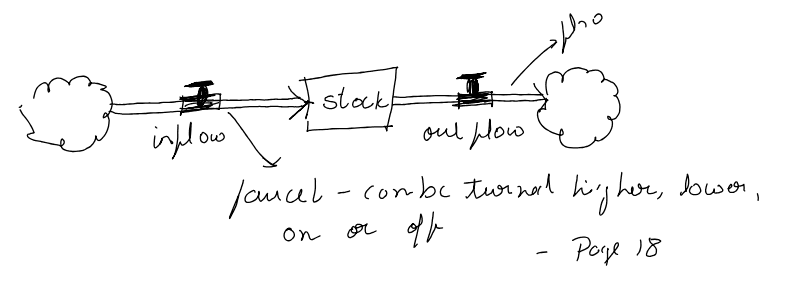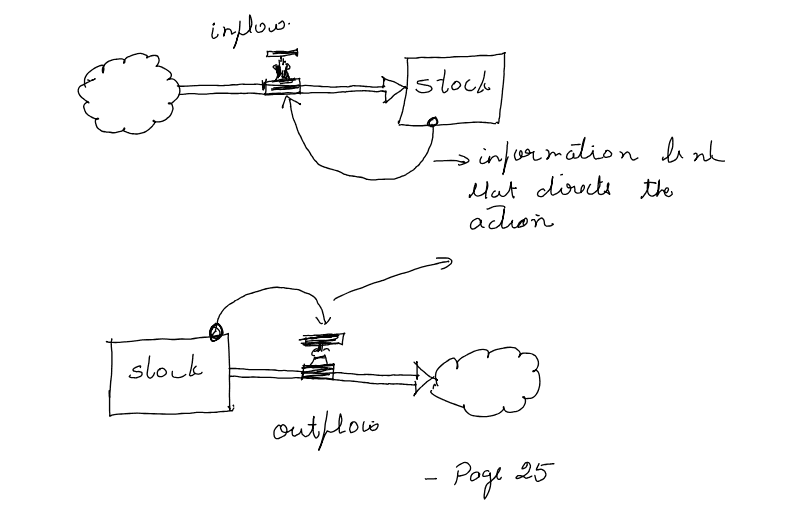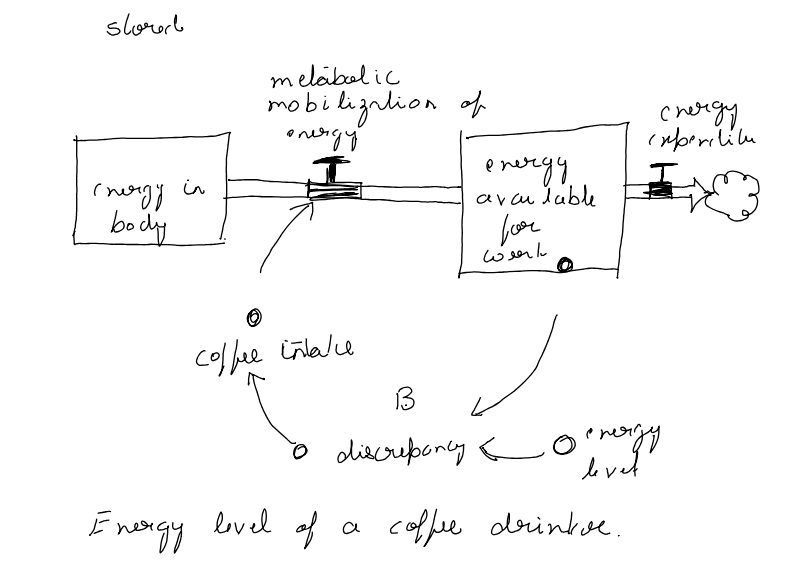Thinking in Systems: A Primer
by: Donella H. Meadows
The answer lies within the slinky itself. The hands that manipulate it, supress or release some behavior that is latent within the structure of the spring.
- Can you identify the parts? … and
- Do the parts affect each other? … and
- Do the parts together produce an effect that is different from the effect of each part on its own? … and perhaps
- Does the effect, the behavior over time persis in a variety of circumstances?



A lock with two competing Balancing loops - a thermostat
- Are the driving factors likely to unfold this way?
- If they did, would the system react this way?
- What is driving the driving factors?
A renewable stock constrained by a non-renewable stock - on oil economy
- overshoot and adjustment to a sustainable equilibrium
- overshoot beyond that equilibrium followed by oscillation around it, and
- overshoot followed by collapse of the resource and the industry dependent on the resource.
Nonlinear systems generally cannot be solved and cannot be added together … Nonlinearity means that the act of playing the game has a way of changing the rules … That twisted changeability makes non linearity hard to calculate, but it also creates rich kinds of behaviors that never occur in linear systems.
- Janis Gleick, author of Chaos: Making a New science
The Trap: Policy Resistance
When various actors try to pull a system stock toward various goals, the result can be policy resistance. Any new policy, especially if it's effective, just pulls the stock furthur from the goals of the other actors and produces additional resistance, with a result that no one likes, but that everyone expends considerable effort in maintaining.
The Way Out
Let go. Bring in all the actors and use the energy formerly expended on resistance to seek out mutually satisfactory ways for all goals to be realized — or redefinitions of larger and more important goals that everyone can pull toward together.
The tragedy of the commons
In any commons system there is, first of all, a resource that is commonly shared (the pasture). For the system to be subject to tragegy, the resource must not only be limited, but erodable when overused. That is, beyond some threshold, the less resource there is, the less it is able to regenerate itself, or the more likely it is to be destroyed.
The Way Out
Educate and exhort the users so they understand the consequences of abusing the resource. And also restore or strengthen the missing feedback link, either by privatizing the resource so each user feels the direct consequences of its abuse or (since many resources cannot be privatized) by regulating the access of all users to the resource.
The Trap: Drift to Low Performance
Allowing performance standards to be influenced by past performance, especially if there is a negative bias in percieving past performance, sets up a reinforcing feedback loop of eroding goals that sets a system drifting toward low performance.
The Way Out
Keep performance standards absolute. Even better, let standards be enhanced by the best actual performances instead of being discouraged by the worst. Use the same structure to set up a drift toward high performance
The Trap: Escalation
When the state of one stock is determined by trying to surpass the state of another stock - and vice versa - then there is a reinforcing feedback-loop carrying the system into an arms race, a wealth race, a smear campaign, escalating loudness, escalating violence. The escalation is exponential and can lead to extremes surprisingly quickly. If nothing is done, the spiral will be stopped by someone's collapse — because exponential growth cannot go on forever
.The Way Out
The best way out of this trap is to avoid getting in it. If caught in an escalating system, one can refuse to compete (unilaterally disarm), thereby interrupting the reinforcing loop. Or one can negotiate a new system with balancing loops to control the escalation.
The Trap: Success to the Successful
If the winners of a competition are systematically rewarded with the means to win again, a reinforcing feedback loop is created by which, if it is allowed to proceed uninhibited, the winners eventually take all, while the losers are elimitated.The Way Out:
Diversification, which allows those who are losing the competition to get out of that game and start another one; strict limitations on the fraction of the pie any one winner may win (antitrust laws); policies that level the playing field, removing some of the advantage of the strongest players or increasing the advantage of the weakest; policies that devise rewards for success that do not bias the next round of competition.
The Trap: Shifting the burden to the Intervener
Shifting the burdern, dependence and addiction arise when a solution to a systemic problem reduces (or disguises) the symptoms but does nothing to solve the underlying problem. Whether it is a substance that dull's ones perception or a policy that hides the underlying trouble, the drug of choice interferes with the actions that could solve the real problem.
If the intervention designed to correct the problems causes the self maintaining capacity of the original system to atrophy or erode, then a destructive reinforcing feedback loop is set in motion. The system deteriorates; more and more of the solution is then required. The system will become more and more dependent on the intervention and less and less able to maintain its own desired states.
The Way Out
Again the best way out of this trap is to avoid getting in. Beware of symptom-relieving or signal-denying policies or practices that don't really address the problem. Take-the focus off short-term relief and put it on long-term restructuring
The Trap: Rule Beating
Rules to govern a system can lead to rule beating - perverse behavior that gives the appearance of obeying the rules or achieving the goals, but that actually distorts the system.
The Way Out
Design, or redesign, rules to release creativity not in the direction of beating the rules, but in the direction of achieving the purpose of the rules.The Trap: Seeking The Wrong Goal
System behavior is particularly sensitive to the goals of feedback loops. If the goals — the indicators of satisfaction of the rules — are defined inaccurately or incompletely, the system may obediently work to produce a result that is not really intended or wanted.
The Way Out
Specify indicators and goals that reflect the real welfare of the system. Be especially careful not to confuse effort with result or you will end up with a system that is producing effort, not result.
A delay in a feedback process is critical relatvite to rates of change in the stocks that the feedback loop is trying to control. Delays that are too short causes overreaction, 'chasing your tail,' oscillations amplified by the jumpiness of the response. Delays that are too long cause damped, sustained or exploding oscillations, depending on how much too long. Overlong delays in a system with a threshed, a danger point, a range past which irreversible damage can occur, cause overshoot and collapse.
… delays are not often easily changeable. Things take as long as they take.
The shared idea in the minds of society, the great big unstated assumptions, constitute that society's paradigm, or deepest set of beliefs about how the world works.
…
Money measures something real and has real meaning; therefore, people who are paid less are literally worth less. Growth is good. Nature is a stock of resources to be converted to human purposes. Evolution stopped with the emergence of Homo sapiens. One can 'own' land. Those are just a few of the paradigmatic assumptions of our current culture, all of which have utterly dumbfounded other cultures, who thought them not the least bit obvious.
In a single individual it can happen in a millisecond. All it takes is a click in the mind, a falling of scales from the eyes, a new way of seeing. Whole societies are another matter - they resist challenges to their paradigms harder than they resist anything else.
So how do you change paradigms? Thomas Kuhn, who wrote the seminal book about the great paradigm shifts of science, has a lot to say about that. You keep pointing at the anomalies and failures in the old paradigm. You keep speaking and acting, loudly and with assurance, from the new one. You insert people with the new paradigm in places of public visibility and power. You don't waste time with reactionaries; rather, you work with active change agents and with the vast middle ground of people who are open-minded.
Systems modelers say that we change paradigms by building a model of the system, which takes us outside the system and forces us to see it whole.
Before you disturb the system in any way, watch how it behaves.
…
Learn its history. Ask people who've been around a long time to tell you what has happened. If possible, find or make a time graph of actual data from the system - people's memories are not always reliable when it comes to timing.
Pay Attention to What is Important, Not Just what is Quantifiable
Our culture obsessed with numbers, has given use the idea that what we can measure is more important than what we can't measure.
Pretend ng that something deesnt exist-if it's hard to quantify leads to faulty models. You've already seen the system trap that comes from setting goals around what is easily measured, rather than around what is important. So don't fallinto that trap. Human beings have been endowed with not only with the aibitity to count, but also with the ability to assess quality. Be a quality detector. Be a walking, noisy Geiger counter that registers the presence or absence of quality.
If something is ugly, say so. If it is tacky, inappropriate, out of proportion unsustainable, morally degrading, ecologically impoverishing, or humanly demeaning, don't let it pass. Don't be stopped by the 'if you can't define it and measure it, I don't have to pay attention to it' ploy.
Go for the Good of the Whole
Remember that hierarchies exist to serve the bottom layers, not the top. Don't maximize parts of the systems or subsystems while ignoring the whole.
Locate Responsibility in the system
That's a guideline both for analysis and design. In analysis, it means looking for the ways the system creates its own behavioror. Do pay attention to the triggering events, the outside influences that bring forth one kid of behavior from the system rather than another.
…
'Intrinsic responsibility' means that the system is designed to send feedback about the consequences of decision making directly and quickly and compellingly to the decision makers.
Stay Humble, - stay a Learner
…
The thing to do, when you don't know, is not to bluff and not to freeze but to learn. The way you learn is by experiment — or, as Buckminister Fuller put it, by trial and error, error, error. In a world of complex systems, it is not appropriate to charge forward with rigid undeviating directives. 'Stay the course' is only a good idea if you're sure you're on course. Pretending you're in control even when you aren't is a recipe not only for mistakes, but for not learning from mistakes. What's appropriate when you're learning is small steps, constant monitoring, and a willingness to change course as you find out more about where it's leading.
Expand Time Horizons
?…
The longer the operant time horizon, the better the chances for survival.
Defy the Disciplines.
In spite of what you majored in, or what the textbooks say, or what you think you're an expert at, follow a system wherever it leads. It will be sure to lead across traditional disciplinary lines. To understand that system, you will have to be able to learn from - while not being limited by - economists and chemists and psychologists and theologians. You will have to penetrate their jargons, integrate what they tell you, recognize what they can honestly see through their particular lenses, and discard the distortions that come from the narrowness and incompleteness of their lenses. They won't make it easy for you.
Don't Erode the Goal of Goodness
The most damaging example of the systems archetype called 'drift to low performance' is the process by which modern industrial culture has eroded the goal of morality.
